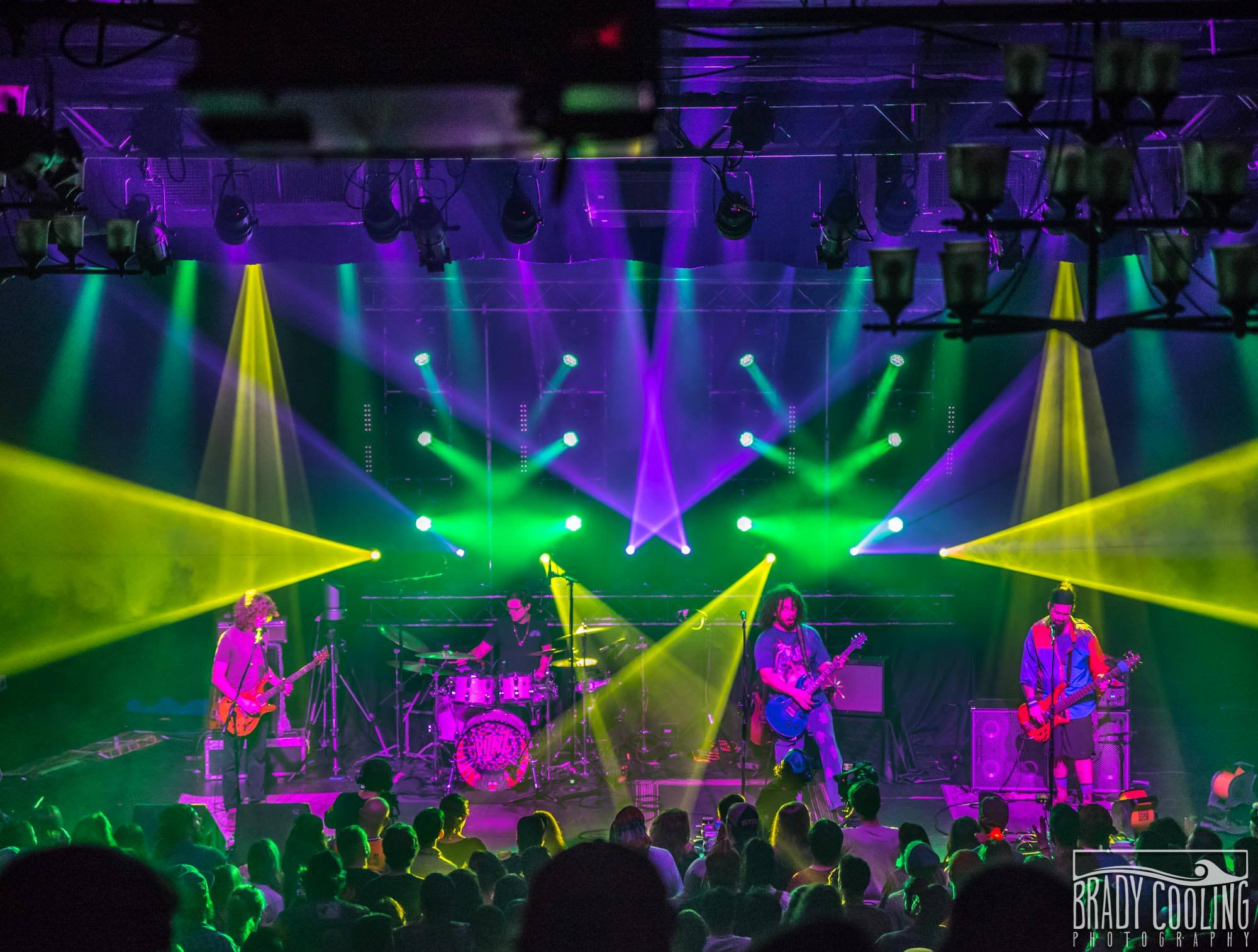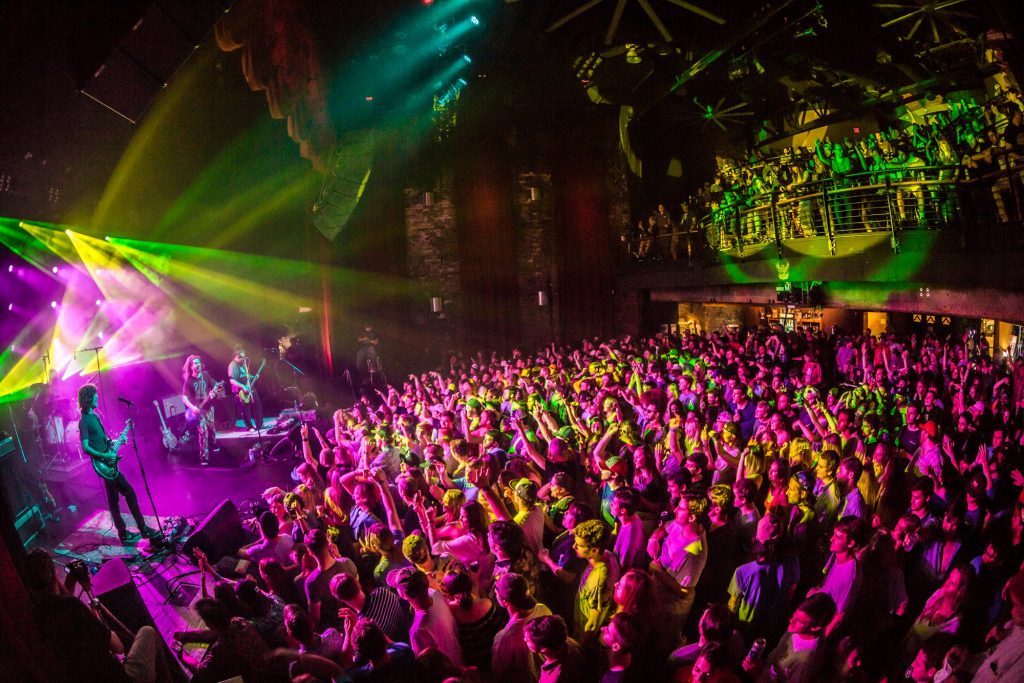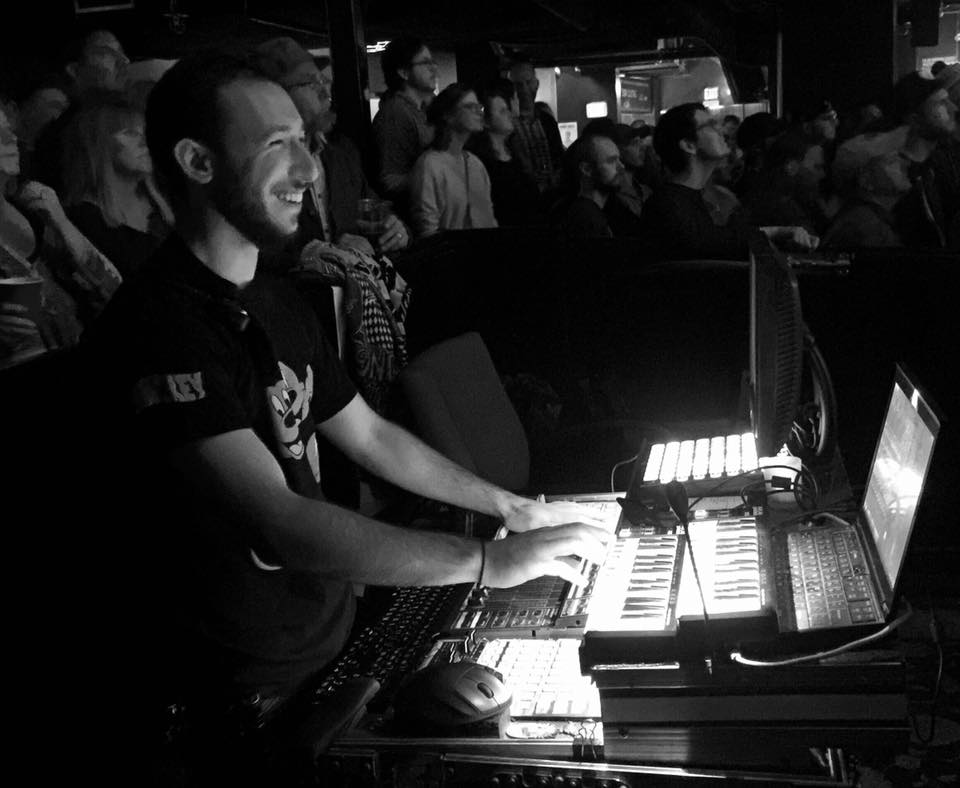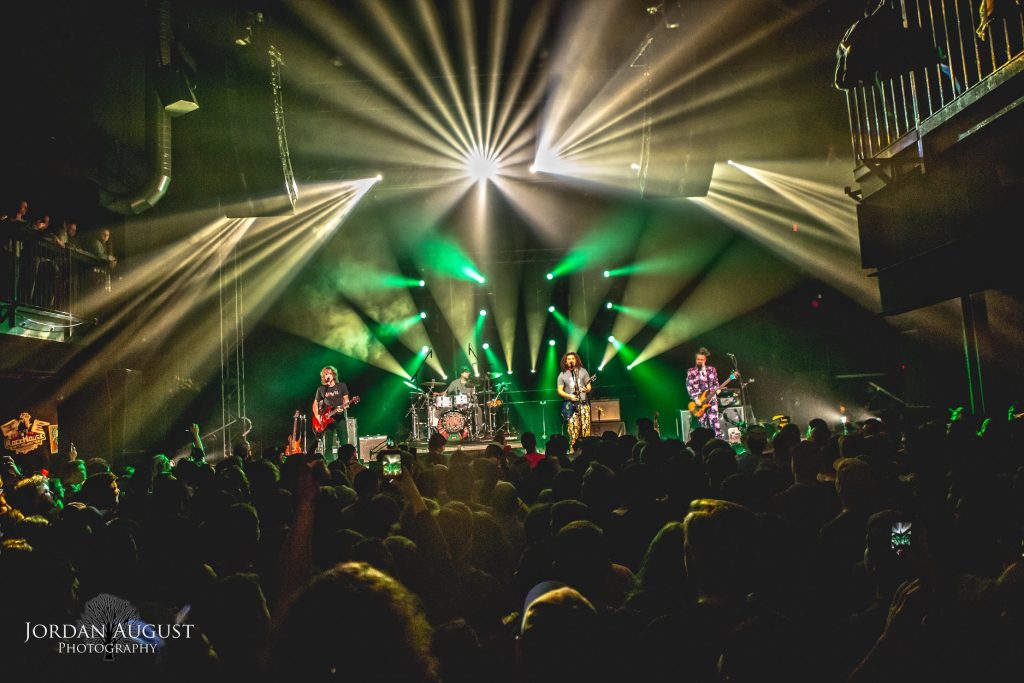
I had the honor of sitting down with Pigeons Playing Ping Pong’s Lighting Designer, Manny Newman, on Thanksgiving weekend. The “high-energy psychedelic funk” band from Baltimore has soared to new heights, selling out shows coast to coast at ~1,000-2,000 capacity venues. They’re getting excellent slots at major festivals like Bonnaroo, Peach, & Lockn, in addition to gigs at legendary venues like Red Rocks. Over the years, I’ve developed great friendships with the guys, which is extra special, being that they’re also my favorite band! I even wrote an article on them back in 2015, which also addresses their visuals during a live performance. (Visual Tips for Aspiring Musicians.) Most of us die hard Flock fans (Pigeons Playing Ping Pong’s Facebook Group Fan page) know that 2019 will be HUGE for them! Lighting Designer Manny Newman has been an integral part of Pigeons Playing Ping Pong since 2015. Anyone that’s ever been to a Pigeons show, knows how much Manny CRUSHES it on lights!!! Manny opens up on his experiences and influences as a lighting designer for one of the hottest bands out there! We love you Manny! Enjoy! Dr. Rich Barnstein Professional Vision
1. Where are you from? Staten Island, NY
2. Who are your favorite music influences? Definitely Phish! Phish is the 1st band that got me into the jam scene. They showed me what a live show’s really all about. So Phish is definitely my biggest one. The next one would probably be Rush. I love Rush. Progressive rock, & the canadian holy Trinity! They can make a lot of noise for 3 people, and obviously time signatures on Neal Pert are really badass. So, yes…Phish & Rush were definitely big when I was growing up.
3. How did you get started in Lighting Design? Originally I was working at the place B&H in the city. I was working in the Pro Audio department, selling recording equipment, and I decided to open up my own recording studio in Queens…and I found out a few months later that market was pretty flooded. That anyone with an audio interface could open up a recording studio. So I wasn’t getting too many clients. That year that I opened up the studio, I was going to see a lot of Phish shows, which was 2010-11. Phish inspired me to buy some lights and see what the lighting world was all about. I would say 2011 MSG New Year’s was the time where I pointed to Chris Kuroda, and was like, “I want that guy’s job!” I kind of went head first into the world of lighting design where eventually I ended up getting more phone calls for lights than I did for sound. So I sold my recording studio in Queens, and went all in for lighting. Then, my first festival I had to work, I actually had to pay to work. It was a festival at a hotel in upstate New York, and I was getting paid like 80 bucks to work the smallest stage. They were charging artists a discounted price on the hotel rooms, which wounded up costing like $160 which was more than I made to work the festival. But at that festival, I got scouted by my friend Evan Antel, who got me a bunch more festival gigs that summer. Basically I was the lighting guy in all of the east coast for all of the festivals pretty much, in the small jam scene world…and then that’s where I met Pigeons Playing Ping Pong.

4. How did you cross paths with Pigeons Playing Ping Pong? The first festival I met them at was I think Wormtown or Strangecreek..one of those because it’s the same location & hard to tell which one it was. They were doing a late night set and their previous LD Aaron Kovelman AKA Ronny RedRocks, came in with this console, and he was programming while I was running another show, & I was worried that he was going to get all of his work done on time, but he got it done, the show went, & I was like “Wow” he really knows how to run a show…and I went over to him after the show, & I was like “Wow you really know your shit! I’ve seen a lot of LDs and there’s not too many that actually get it” and he was definitely one that got it. And I was like “Yeah we should definitely be in touch” and we basically kept in touch…and I was seeing Pigeons shows anytime they were playing locally, like Brooklyn Bowl, or Garcia’s, which is part of the Capitol Theater. Then eventually, Ronny got the phone call to do Tritonal, & Cash Cash, & The Chainsmokers, and he asked me if I wanted to do Pigeons, and of course I was like “Yeah!” I love their shit & I would be honored. At that time I was also out of a job because I was working with this band previously called FiKus. They’re from Nyack New Jersey, and they put out an album, and as soon as they put out the album they decided to part ways. So I was pretty much out of a job. Also, I was working with Electron, but that was only part-time so it was only like a couple of gigs here and there. It wasn’t filling up my space. Summer was the time I’d make the most money because of freelance festival gigs. So when I got the phone call to do Pigeons I was really excited. I was like this was going to take up all of my time and I actually believe that these guys can take it all the way, so I invested my full time in them.

5. Who are your biggest lighting designer influences? Number one..Chris Kuroda..the wizard…jedi…he’s my biggest influence. A Phish show in 2011 MSG…was the 1st time I had a different view on the whole way of operating lights. I became more present in understanding actually what he’s doing and why he’s doing it as opposed to just flash and trash and just “oh things go wide and things go big and things change colors.” I actually understood why he’s doing it. So Chris Kuroda is definitely someone I study. I watch so many videos. In 2011 through 2012 I was studying all of those videos from that tour. So he’s actually a huge influence on my work. Number 2 probably Jefferson Waful with Umphrey’s McGee. His color theory is just on point. His execution…very precise, and he’s someone that knows how to hold back for a 2nd set and that taught me to not just blow your load on the 1st set, and like “here’s all of your tricks.” Save it for the 2nd set, because that’s when things get weird, and you gotta keep the show interesting. That evolution of the show, Jefferson taught me, just by watching his shows. Number 3 I would go with Saxton Waller who used to do lights for STS9. His programming was so clean. His operating was top notch. I wish he was still with STS9 because he hit a really nice peak, and kind of went off after that to do his own thing. Then I would say number 4 would probably be Candace Brightman of the Grateful Dead, which I only saw her work with the Fare Thee Well. Which was when Trey played with the Grateful Dead, which was awesome for me. I was like 10 feet in front of Trey every night, which was an awesome experience. She showed me the way to be a little more delicate with the way you run your show. It’s not just pop-pop. Try to get transitions. Also the same idea with evolution, where it leads into the set to get a little more intense. Luke Stratton of Dopapod…he was a pioneer in the midi lighting world. I remember seeing him at my 1st Catskill Chill. He was by front of house, and he had all of his APC setups, and I go over to him, and I’m like, “Are you using Ableton behind here?” And he’s like, “No.” And I just think for a second, & I’m like, “What is he doing? What could he possibly be doing?” and I’m like “Lights?” And he’s like, “Yeah!” and that kind of blew my mind. I’d never seen anyone operate lights, with midi controllers. It proved the concept of where you could actually afford to be a lighting designer without having to buy a $60,000 console, which was my biggest deal. I can’t afford a $60,000 console. Most people can’t. So, to find out that you could actually just buy the node, and then connect your midi controllers to a laptop…a little programming…you have the power of a $60,000 console. That opened the whole world for me, so Luke Stratton is a pioneer in that sense, and he is also my teacher for grand MA. I took 2 days of lessons at Eli Winderman’s parent’s house, and he taught me grand MA in 2 days. He’s a fantastic teacher. His lighting design work plays a huge part in the way I operate. All of those lighting designers, are a culmination of what I do right now. I try to take what I like from everyone, and that’s a Pigeons light show. (laughs)

6. How do you approach each show strategically? (Some of the basics between venues, themes, & festivals) When we’re on tour, our light rig is broken up into 3 possible packages, depending on all of the lights and the structures we have. Called the “A”, "B” & “C” package. “C” is the smallest, “B” being medium, and “A” being the full large one where we have space. Every venue we go to, as soon as we get there, we take a look at the ceiling height / the clearance…if we could fly a truss or do we need to stack things on the ground? So as soon as we get there, we know whether we need to do the “C”, “B”, or “A” package. “A” package is obviously the best package we could possibly do, and it’s always a treat to do it, but the C package is also a very powerful package. We have our spots, washes, and strobes. It’s pretty much what you need to run a show. With festivals, it’s a little different, because we don’t always have the time to set up light rigs. Sometimes we do, but the times we don’t, what they do is send us a light plot, which is what they’re going to have at the festival. I get this light plot, and usually a week before the festival, I go in my little programming room, and I build the stage in 3D…and I program and clone the Pigeons light show to the fixtures that the festival is going to have, and try to make it look as much as the current programming as possible. When I do it in 3D it usually takes about a day or 2 to get it really nice and tight. Then when I go to the festival and plug in my console, it takes a little updating here and there, and everything is pretty much up to looking good and I’m happy with it…most of the time. (laughs) I would say 98% of the time it works all the time. (laughs) Which doesn’t make any sense. So that’s how we build our rigs at festivals.

7. Flock fans consider you to be one of the band. Did you ever envision Pigeons to be where they’re at, where they’ve come from, and to where many of us think they’re going? Yeah definitely! I think I came to a realization where this could be the future and the next generation of jam bands. I remember when one of my friends, Asaf Weiss, came over to me, where he was big into Phish at the time, and he was like, “Dude! You gotta see Pigeons!” and he had that face, the UFO meme guy, where it’s just like “UFO’s…Pigeons!” and I was like, “Okay, you seem like you’re tripping right now.” and he was completely sober…and something struck me as like maybe I should really go delve deeper into this band and see what they’re about. So when I started seeing shows I was like, “Okay! This is a lot of fun!” and I remember this one moment at the Chameleon Club when I was working with them. I had this flashback where it was this same feeling as when I was at a Phish show, and I was like, “Oh wow! I haven’t felt that in a while!” And that kind of also was like, “Okay this could be it! We have something here!” I know everyone has really good chemistry, and we have a really well oiled machine. So I definitely thought and believed that they could take it all the way. I had that vision, and that’s why I took the job, because I felt that they could do it. I don’t like to take jobs from bands that sound generic where they don’t have their own sound necessarily which okay sounds a little bad that I’m not going to be taking jobs for every band, but I really have to believe in what they’re doing. And the music that they’re putting out there instead of generic stuff, they have to have an original sound…2 guitars no keys..it’s unique. I remember when we did the Dead Phish set at Domefest, we played “Slave to the Traffic Light”, and there’s this one piano part that Page usually plays, and I’m wondering, “who’s gonna do this?” and Greg puts on his Flanger pedal, and just plays Page’s part perfectly, and I’m like, “Ahhh that’s how he does it!” They know how to adapt, and make it sound like Pigeons, because of that. That’s what give it their sounds. I love how unique they are, and the music they put out there. I definitely think they can that they can take it all the way, and that’s why I’m working with them. Rich: “Nice! We (The Flock) feel the same way!”

8. And speaking of the Flock, did you ever think you would be part of a band with such loyal, obsessed passionate fans? Over 17,000 (*as of 11/23/18) on the Flock Facebook fan page and rising! No, I didn’t. I remember when I first joined Facebook in high school, groups weren’t big. (Laughs) Nobody cared about groups. Okay, you’re in a group for some funny memes every so often, and even when I joined the band, I was like, “What is this Flock thing? What’s this gonna be? Just people like saying dumb things?” and little did I know that it was going to turn into something more than that, a community. They developed a very loving community, that is just amazing, to see grow. I remember when there wasn’t that many fans of the Flock, and now I think there at 17,000 or something? A lot of active members, and it’s just beautiful to see the love out there that fans can provide to each other and the band. It’s really good to see that it grew to what it is, because I did not think (Facebook) Groups were a thing til I saw the Flock!

9. As a Lighting Designer, what are some of your goals, tour to tour, year to year, with Pigeons? I’m gonna basically say that, Chris Kuroda had this interview. I listen to all of his interviews, and the biggest thing with the band is evolution, and I also feel the same way. I want the band to evolve musically obviously, and production. I don’t wanna gung ho it, where I’m gonna go like the best lights and the best everything I can right away, because if you do like the best all the way and give it all you got, you don’t leave room for improvement. Obviously you could improve from where you are, but you gotta leave that space you know how to spread out throughout the years, so you can see the evolution. I always try to, every couple seasons, make the rig a little better, a little more programming, and switch my operating, to where it becomes interesting to me, because I’ve been to the most Pigeons shows ever. The show has to be interesting to me. I always strive to entertain myself, which is probably the hardest thing, because I see the same thing all the time. Although no show is the same. I don’t have one song pre-programmed. There’s no play button on anything. I play everything. So if you see a mistake, it’s because it’s live. (laughs) But I tend to do a lot of the same things for certain parts of the music, but every so often I just feel like, “You know what? I’m going to try something different” to push this evolution, that I really believe in, and to make a different flow happen. Every so often I always draw out some designs and see what the future light rigs could possibly look like. We have a couple in the bag. I have a couple of ideas for future rigs. “A” packages, and I’m excited to bust them out eventually.

10. From a visual lighting designer perspective in connecting with live music, what’s your advice to other bands and artists trying to make it in the live music scene? I would say you have to really want it, and you have to keep working, because as soon as you feel comfortable, that’s when I think you fail, honestly. You really have to always be hungry. Sometimes you gotta hustle, but usually if you have talent, people will notice. So, keep working, and always learn…constant education…never feel like you know everything…never plateau…leave room for evolution….to keep doing you…you do you! (Laughs) Rich: Thank you!


